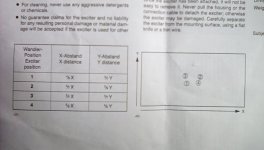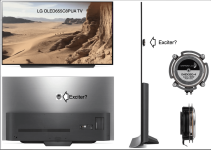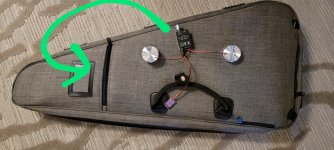Asked before, but no previous reply....
I could use some advice in the placement of a pair of Thrusters on the back of my LG TV to use as a center channel in my home theater.
I need more output from this panel in respect to my main DMLs. I'll drive each exciter with a dedicated amplifier.
The acrylic panel available to operate as a DML is fixed at its base (3 free edges sides and top) and has the dimensions of 57" wide x 19" high.
I originally had a single Thruster mounted in the center of the rectangle. It sounded quite good, just not enough relative output.
Suggestions appreciated.
I could use some advice in the placement of a pair of Thrusters on the back of my LG TV to use as a center channel in my home theater.
I need more output from this panel in respect to my main DMLs. I'll drive each exciter with a dedicated amplifier.
The acrylic panel available to operate as a DML is fixed at its base (3 free edges sides and top) and has the dimensions of 57" wide x 19" high.
I originally had a single Thruster mounted in the center of the rectangle. It sounded quite good, just not enough relative output.
Suggestions appreciated.
Frubdoo.
Is it an electric or an acoustic guitar you are using this panel for ?
The weights or mounting points will help fill in the response between 100hz and 200hz.
The spine will also protect the exciter, preventing it from ripping off if accidentally dropped.
A blob of blu-tack in the centre of the coil area will also help damp the high frequency peaks, so that you can adjust the sound a little to your preference.
Be warned that wood does warp over time , I'm not sure what to coat the panel in to stop this ?
Typical Ben used perspex but this material has a rising response and is quite harsh at the top end.
Maybe others have ideas for more suitable materials ?
The problem is that the panel must be very robust to handle the amount of knocking about it is going to get.
Steve.
Electric Guitar
really just looking to make small practice amp speakers that fit into guitar case storage compartment. They do not have to sound great.
I've thought about mounting two small exciters directly on to the $3000 guitar.
I could care less.
ordered more than $200 of materials from woods to carbon fiber in my quest to build the best flattest 8 inch guitar speakers!
I have posted this before ,it is is the NXT position for up to 4 exciters.Asked before, but no previous reply....
I could use some advice in the placement of a pair of Thrusters on the back of my LG TV to use as a center channel in my home theater.
I need more output from this panel in respect to my main DMLs. I'll drive each exciter with a dedicated amplifier.
The acrylic panel available to operate as a DML is fixed at its base (3 free edges sides and top) and has the dimensions of 57" wide x 19" high.
I originally had a single Thruster mounted in the center of the rectangle. It sounded quite good, just not enough relative output.
Suggestions appreciated.
I usually use position one only.
Hope this helps you.
Steve.
Attachments
Hello Aagas,Asked before, but no previous reply....
I could use some advice in the placement of a pair of Thrusters on the back of my LG TV to use as a center channel in my home theater.
I need more output from this panel in respect to my main DMLs. I'll drive each exciter with a dedicated amplifier.
The acrylic panel available to operate as a DML is fixed at its base (3 free edges sides and top) and has the dimensions of 57" wide x 19" high.
I originally had a single Thruster mounted in the center of the rectangle. It sounded quite good, just not enough relative output.
Suggestions appreciated.
I haven't experienced multi-exciter yet. What I have in mind it is an opportunity to make a balance driving system; The exciters being symmetrical in reference to the center of the panel. This is nice with a panel having four edges identical... in your case with one clamped edge and 3 free edges, is it the same?
To fully understand : is it the 57" side which clamped at the base? Where will be the panel compare to the TV (behind? in front below?...)?
Christian
The panel, is the portion of the TV's OLED panel extending above its box which contains the electronics.Hello Aagas,
I haven't experienced multi-exciter yet. What I have in mind it is an opportunity to make a balance driving system; The exciters being symmetrical in reference to the center of the panel. This is nice with a panel having four edges identical... in your case with one clamped edge and 3 free edges, is it the same?
To fully understand : is it the 57" side which clamped at the base? Where will be the panel compare to the TV (behind? in front below?...)?
Christian
See attached image, which reflects how I originally used the exciter on the TV.
Attachments
Hi Steve,I have posted this before ,it is is the NXT position for up to 4 exciters.
I usually use position one only.
Hope this helps you.
Steve.
This certainly helps. Many thanks.
Andreas
I did a comparison between 1 and 2 exciters on the same panel, looking for any evidence of comb filtering, or other obvious negative effects of a second exciter. The panel is 14" x 48" x 5 mm, 5 ply plywood (triply), attached to a rigid frame around the perimeter, except at the corners. The exciter(s) are Dayton Audio DAEX25FHE-4. I placed the first exciter in a spot that works pretty well, which is about 5" and 2" off center in the long and short dimensions, respectively. For the 2 exciter case, I put the second exciter in the center of the panel. I picked the center for no particular reason, and certainly not because it was a particularly good (or bad) position. The mic was positioned 1 meter from the face of the panel, directly in front of the first exciter. This ensured that the distance from each exciter to the mic was slightly different.
The first comparison below is the frequency response with 1/6 smoothing. The upper curve is 2 exciters, and the lower is with 1 exciter. Probably with the 1/6 smoothing, the resolution wouldn't be good enough to easily detect comb filtering, but still allows a good overall comparison over the entire frequency range. Certainly the two are different, which I would expect. But frankly, despite the fact that I made no attempt to optimize the position of the second exciter, the result is still pretty decent, and not clearly better or worse than the single exciter case. Both responses exhibit a deep dip at about 120 Hz, but otherwise there is nothing remarkably bad about either response.

The results below are the same measurements, but with 1/48 smoothing. This provides much more resolution, which I think would be sufficient to reveal comb filtering, if there was any. However, the 2 exciter case doesn't show any evidence, as far as I can tell, of any of the nulls typical of comb filtering, let alone a series of nulls with regular spacing.

Is there another measurement I could try? If anyone can share results that actually show something that looks like it could be comb filtering, please share. I'd be interested to see it.
Eric
The first comparison below is the frequency response with 1/6 smoothing. The upper curve is 2 exciters, and the lower is with 1 exciter. Probably with the 1/6 smoothing, the resolution wouldn't be good enough to easily detect comb filtering, but still allows a good overall comparison over the entire frequency range. Certainly the two are different, which I would expect. But frankly, despite the fact that I made no attempt to optimize the position of the second exciter, the result is still pretty decent, and not clearly better or worse than the single exciter case. Both responses exhibit a deep dip at about 120 Hz, but otherwise there is nothing remarkably bad about either response.

The results below are the same measurements, but with 1/48 smoothing. This provides much more resolution, which I think would be sufficient to reveal comb filtering, if there was any. However, the 2 exciter case doesn't show any evidence, as far as I can tell, of any of the nulls typical of comb filtering, let alone a series of nulls with regular spacing.

Is there another measurement I could try? If anyone can share results that actually show something that looks like it could be comb filtering, please share. I'd be interested to see it.
Eric
Hello EricIs there another measurement I could try?
Another measurement I don't know but another post-treatment of those measures yes. Start from them with no smoothing or 1/48 smoothing. Then in "Tools" > "IR Windows". In the box appearing check "Add frequency dependent window" and select "Width in octaves" 1/6. then "Apply Windows To All".
Is there a difference now? I found one when I did that. My problem is at this step I am not able to say if there is something or is it a misuse of REW?
If yes may be have a look in the spectrogram (wavelet) to check if the arrival time is the same in HF for both.
Christian
Eric...But frankly, despite the fact that I made no attempt to optimize the position of the second exciter, the result is still pretty decent, and not clearly better or worse than the single exciter case.
Did you play any music/vocals in both cases ? and if so, was there any discernible subjective difference between the two in terms of clarity which would indicate interference?
Eucy
Thanks for taking these measurements! If you adjust the volume of both responses to be equal, is the harmonic distortion or noise measurement better for one or the other?Is there another measurement I could try?
I'm not sceptical Eric, it's a subjective assessment, and in my view, ears are the ultimate measure.. Even my compromised ones 😵💫🤭🥴🙉Eucy,
First, I'm pretty skeptical of anyone's subjective impressions, as you should be of mine. That said, I listened to Nora Jones sing "Don't Know Why" about five times with each configuration. Both sounded great, I did not have a preference.
Eric
Eucy
Frubdoo.
how are you going to mount you panel so the the panel surface is not touching anything ?
it will buzz heavily otherwise .
Steve.
Steve
I came up with joke this morning:
"How do you explain to an audiophile you are looking for mediocre quality at best? You can't!"
Thank you for engaging and going through this thought experiment with me.
This is my current guitar practice setup. I also have nicer Dayton exciters that just came in.
I set them right on the soft case and it is "pretty good" to practice guitar.
I won't be recording with Adele anytime soon, but it works.
The green arrow is the pocket where I would store the exciters attached to some substrate.
I would turn them the other way with the substrate parallel to the ceiling sitting on the case.
Not looking for anything great, but this alone has been good enough for practice with no substrate.
So i've ordered 6x8" bamboo carbon fiber etc to see if I can do a "little better" and still fit in that pocket.
Attachments
Frubdoo.
those exciters screw onto the panle and are pretty robust I believe.
So no trouble if ply panel warping over time,good choice.
Maybe you could give us a sound recording using your phone when you have set it all up.
For music, one Exciter should be fine but loud guitar twangs could be a problem for a single Exciter, so maybe two exciters will help ?
I'd prefer to call the panels , sound boards or sounding boards as in the old days , the same as a piano or guitar, but dml is the new name, which as far as I am concerned just seems to confuse everyone.
Steve.
those exciters screw onto the panle and are pretty robust I believe.
So no trouble if ply panel warping over time,good choice.
Maybe you could give us a sound recording using your phone when you have set it all up.
For music, one Exciter should be fine but loud guitar twangs could be a problem for a single Exciter, so maybe two exciters will help ?
I'd prefer to call the panels , sound boards or sounding boards as in the old days , the same as a piano or guitar, but dml is the new name, which as far as I am concerned just seems to confuse everyone.
Steve.
Ok
First is using the case and a backing track with me playing terrible guitar
second is an audio file
No bad for placing directly on a guitar case and having a battery pack powered practice amp thats thin
If a small ply panel makes it sound even better, I am done.
this is crazy how good these things are with my soft case as the substrate. what a can of worms and waste of money joining this forum!
First is using the case and a backing track with me playing terrible guitar
second is an audio file
No bad for placing directly on a guitar case and having a battery pack powered practice amp thats thin
If a small ply panel makes it sound even better, I am done.
this is crazy how good these things are with my soft case as the substrate. what a can of worms and waste of money joining this forum!
Attachments
Frubdoo
This was a post I made on audiocircle you might be interested in.
It was a panel I made for a full range audio , but thought it might make a good panel for acoustic guitar in a small hall.
It is cheap to make and robust , your Exciter was not around ,that I know of anyway ,or I would have used it.
Thought you might be interested ?
I did make recordings on this site with me walking around the room and out into the garden.
Steve.
https://www.audiocircle.com/index.php?PHPSESSID=os5i1q7riek6dblg94ieqf0slf&topic=138277.40
This was a post I made on audiocircle you might be interested in.
It was a panel I made for a full range audio , but thought it might make a good panel for acoustic guitar in a small hall.
It is cheap to make and robust , your Exciter was not around ,that I know of anyway ,or I would have used it.
Thought you might be interested ?
I did make recordings on this site with me walking around the room and out into the garden.
Steve.
https://www.audiocircle.com/index.php?PHPSESSID=os5i1q7riek6dblg94ieqf0slf&topic=138277.40
Hi Christian,Hello Eric
Another measurement I don't know but another post-treatment of those measures yes. Start from them with no smoothing or 1/48 smoothing. Then in "Tools" > "IR Windows". In the box appearing check "Add frequency dependent window" and select "Width in octaves" 1/6. then "Apply Windows To All".
Is there a difference now? I found one when I did that. My problem is at this step I am not able to say if there is something or is it a misuse of REW?
If yes may be have a look in the spectrogram (wavelet) to check if the arrival time is the same in HF for both.
Christian
I saw that from your earlier post, but my results are different from what you saw with the addition of the frequency dependent window. The plot below includes a 1/6 frequency dependent window, as you suggested.

In my case, when I add the frequency dependent window, it introduces two dips in the response for the single exciter case, but not the 2 exciter case. Like you, I'm not really sure of the significance, if any, of this result.
Eric
- Home
- Loudspeakers
- Full Range
- A Study of DMLs as a Full Range Speaker


